Artemis
Artemis is a series of missions divided into phases, which comprise NASA’s core plan for human spaceflight and exploration for the next decade. It has three primary domains of exploration: low-Earth orbit, the Moon, and Mars.[1] The mission goals include sending the first woman and first person of color to the Moon; exploring more of the lunar surface; establishing a long-term presence on the Moon; and then sending the first astronauts to Mars.[2]
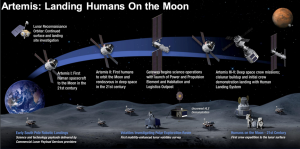
Source: NASA FY 2023 Budget Request
The timeline of the mission as a whole is illustrated in the figure below.
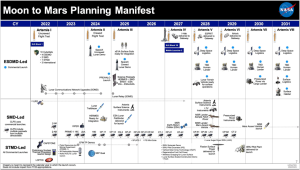
Source: NASA FY 2023 Budget Request
Artemis I
Artemis I is the first in the series of NASA missions. This mission will test NASA’s deep space exploration system, which will be comprised of an uncrewed Orion spacecraft, Space Launch System (SLS) rocket, and Kennedy Space Center’s ground systems in Florida.[3] The Orion Spacecraft is set to launch on November 16, 2022.[4] After flying 62 miles above the surface of the Moon, Orion will use the Moon’s gravitational force to propel itself into an opposite (new deep retrograde) orbit about 40,000 miles from the Moon. It will remain in retrograde orbit for six days to collect data.[5] The Artemis I mission will last approximately 25 days.[6] The Artemis I mission is detailed in the graphic below.
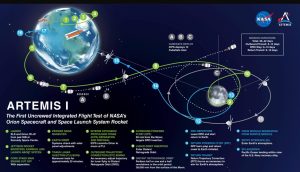
Source: NASA
Artemis II
Artemis II will be the first flight with crew.[7] NASA will send four astronauts as a flight test in preparation for Artemis III, in which the first woman and next man will land on the Moon. After collecting performance data and checking critical systems, the Artemis II crew will fly Orion toward the Moon. The whole Artemis II mission is expected to last just over 10 days and will create a figure eight, extending over 230,000 miles from Earth, as depicted in the mission map below.[8]
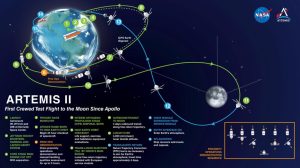
Source: NASA
Artemis III
Artemis III will follow the successful completion of the two test flights. NASA will send the first woman and next man to walk upon the lunar surface.[9] They are anticipated to land on the lunar south pole, for the first time in human history.[10] After which, NASA will launch crewed missions once a year. The primary goal will be the completion of Gateway and setting it in orbit around the moon, which will aid future exploration missions.[11]
Gateway and Artemis Base Camp
The Gateway and Artemis Base Camp will permit astronauts to stay in space for a longer duration of time, with the intention of decreasing the reliance on the Earth for subsequent missions.[12] The Gateway will be the first space station in lunar orbit to support NASA’s deep space exploration plans.[13] It will serve as a transfer hub for astronauts from Orion to the lunar surface by way the lander. The various elements and commercial partners for the Gateway are depicted in the image below.
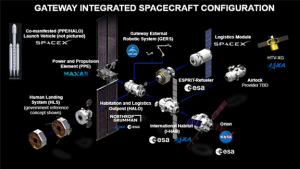
Source: NASA
Currently in the conception stage, the Artemis Base Camp would provide astronauts with a homebase on the Moon.[14] The base camp will be developed at the Moon’s south pole. While the location is yet to be determined, the image below shows sites of interest. The base camp has three primary mission elements: 1) the Lunar Terrain Vehicle (LTV), which will be used to transport crew around the site and the development of two main habitats, that include 2) the habitable mobility platform, which will allow long-duration trips away from base; and 3) a short-stay Surface Habitat designed for a crew of four.[15]

Source: NASA’s Plan for Sustained Lunar Exploration and Development
Together, Gateway and Artemis Base Camp will provide astronauts with sustainable lunar architecture.
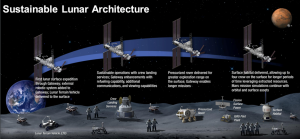
Source: NASA FY 2023 Budget Request
Artemis Partners
Artemis partners are comprised of companies across the United States and throughout Europe. NASA Prime Contractors include Aerojet Rocketdyne, Boeing, Jacobs, Lockheed Martin, and Northrop Grumman. These primes currently have over 3,800 suppliers contributing to Orion, the SLS rocket, and the lunar spaceport at Kennedy.[16]
The prime contractor for Orion, specifically, is Lockheed Martin. Three prime contractors are involved with the Space Launch System; these include Aerojet Rocketdyne, Boeing, and Northrop Grumman. Jacobs is the prime contractor for the Exploration Ground System.[17]
NASA also lists the Small Business Innovation Research (SBIR) program as an Artemis partner. Opportunities for small companies and research institutions to contribute in the development of key technology areas for Artemis are posted in the solicitations of the government-sponsored SBIR program.[18]
Human Landers
In 2020, NASA announced that three U.S. companies will develop the landers responsible for bringing the astronauts to the lunar surface. The three companies awarded with contracts to develop the Human Landing System are Blue Origin, Dynetics, and SpaceX.[19]
Artemis After 2024
After Artemis III, the missions will focus on preparations to enable missions to Mars.[20]
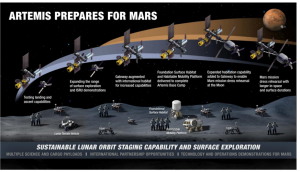
Source: NASA’s Plan for Sustained Lunar Exploration and Development
FY2023 Budget Request
The total budget requested for FY23 in relation to the Artemis missions is $25,973.80 million.[21] The NASA FY2023 Budget Request report provides summaries and breakdowns for each subsection in the budget.
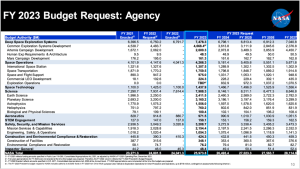
Source: NASA FY 2023 Budget Request
For more information, read the FY23 Budget Request Summary for relevant highlights. Also of interest is NASA’s Plan for Sustained Lunar Exploration and Development, which is an in-depth look at the Artemis mission as a whole.
Updated November 2022 by Jennifer Ostromecki

Comments are closed.